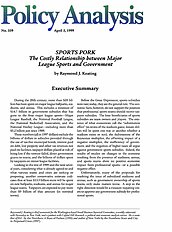These numbers (all in 1997 dollars) exclude the billions of dollars in subsidies provided through the use of tax-free municipal bonds, interest paid on debt, lost property and other tax revenues not paid on facilities, taxpayer dollars placed at risk of being lost if the venture failed, direct government grants to teams, and the billions of dollars spent by taxpayers on minor league facilities.
Looking to the rest of 1999 and the next several years, considering what is already agreed to and what various teams and cities are seeking or proposing, another conservative estimate indicates that at least $13.5 billion more will be spent on new ballparks, stadiums, and arenas for major league teams. Taxpayers are expected to pay more than $9 billion of that amount (in nominal terms).
Before the Great Depression, sports subsidies were rare; today, they are the general rule. The economic facts, however, do not support the position that professional sports teams should receive taxpayer subsidies. The lone beneficiaries of sports subsidies are team owners and players. The existence of what economists call the “substitution effect” (in terms of the stadium game, leisure dollars will be spent one way or another whether a stadium exists or not), the dubiousness of the Keynesian multiplier, the offsetting impact of a negative multiplier, the inefficiency of government, and the negatives of higher taxes all argue against government sports subsidies. Indeed, the results of studies on changes in the economy resulting from the presence of stadiums, arenas, and sports teams show no positive economic impact from professional sports — or a possible negative effect.
Unfortunately, many of the proposals for resolving the issue of subsidized stadiums and arenas, such as government ownership of sports teams, only make matters worse. A step in the right direction would be a measure requiring voters to approve any government subsidy for professional sports.

